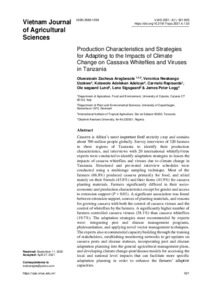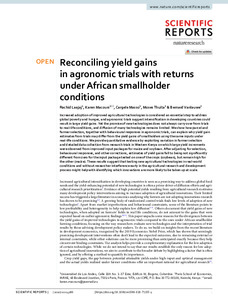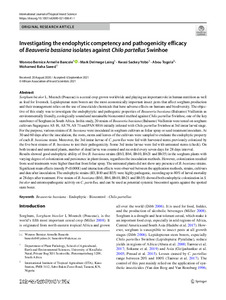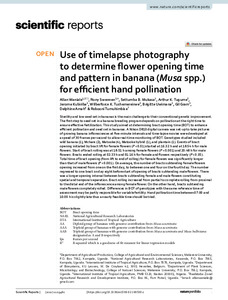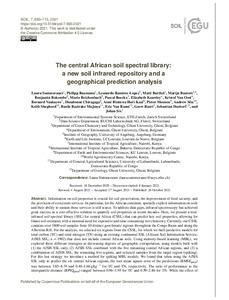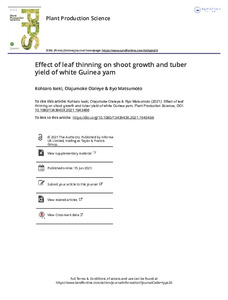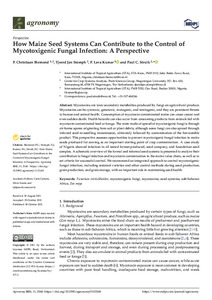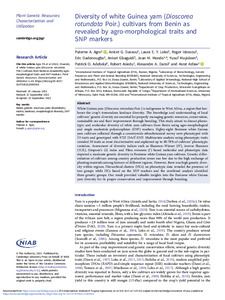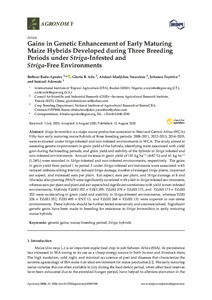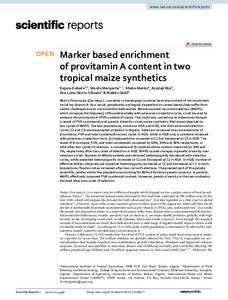Welcome to the International Institute of Tropical Agriculture Research Repository
Journal and Journal Articles: Recent submissions
Now showing items 841-860 of 5157
-
Expansion of the cassava brown streak disease epidemic in eastern Democratic Republic of Congo
(2021-08)Cassava plays a key role in ensuring food security and generating income for smallholder farmers throughout Central Africa, particularly in the Democratic Republic of Congo (DRC). This status is threatened, however, by cassava brown streak disease (CBSD), which has expanded its incidence and range in eastern DRC. The study described here comprises the first extensive assessment of temporal change in the occurrence of CBSD and its causal viruses in DRC, based on surveys conducted during 2016 and ... -
Production characteristics and strategies for adapting to the impacts of climate change on cassava whiteflies and viruses in Tanzania
(2021)Cassava is Africa’s most important food security crop and sustains about 700 million people globally. Survey interviews of 320 farmers in three regions of Tanzania to identify their production characteristics, and interviews with 20 international whitefly/virus experts were conductedto identify adaptation strategies to lessen the impacts of cassava whiteflies and viruses due to climate change in Tanzania. Structured and pre-tested interview schedules were conducted using a multistage sampling ... -
Storage root yield response to leaf harvest of improved and local cassava varieties in DR Congo
(2021)Although cassava is usually grown for its starchy roots, cassava leaves are an important vegetable and protein source in sub-Saharan countries. Eleven cassava mosaic disease (CMD) tolerant and two susceptible varieties were planted in six trials; leaves were harvested at 4, 8 and 11 months after planting (MAP) and storage roots were harvested at 12 MAP. Edible leaf and storage root dry matter yields were strongly affected by variety and interacted with location. Edible leaf yields ranged from 209 ... -
Reconciling yield gains in agronomic trials with returns under African smallholder conditions
(2020)Increased adoption of improved agricultural technologies is considered an essential step to address global poverty and hunger, and agronomic trials suggest intensification in developing countries could result in large yield gains. Yet the promise of new technologies does not always carry over from trials to real-life conditions, and diffusion of many technologies remains limited. We show how parcel and farmer selection, together with behavioural responses in agronomic trials, can explain why yield ... -
Investigating the endophytic competency and pathogenicity efficacy of Beauveria bassiana isolates against Chilo partellus Swinhoe
(2021)Sorghum bicolor L. Moench (Poaceae) is a cereal crop grown worldwide and playing an important role in human nutrition as well as feed for livestock. Lepidopteran stem borers are the most economically important insect pests that affect sorghum production and their management relies on the use of insecticide chemicals that have adverse effects on humans and biodiversity. The objective of this study was to investigate the endophytytic and pathogenic properties of Beauveria bassiana (Balsamo) Vuillemin ... -
Use of timelapse photography to determine flower opening time and pattern in banana (Musa spp.) for efficient hand pollination
(2021)Sterility and low seed set in bananas is the main challenge to their conventional genetic improvement. The first step to seed set in a banana breeding program depends on pollination at the right time to ensure effective fertilization. This study aimed at determining bract opening time (BOT) to enhance efficient pollination and seed set in bananas. A Nikon D810 digital camera was set-up to take pictures of growing banana inflorescences at five-minute intervals and time-lapse movies were developed ... -
A multi-objective model exploration of banana-canopy management and nutrient input scenarios for optimal banana-legume intercrop performance
(2021)Bananas on smallholder farmers in the African Great Lakes region are often pruned to illuminate shorter understory intercrops, reducing overall farm profitability. The impact of this practice on environmental and nutritional indicators are not known. This study determined the effect of this practice on operating profit, protein yield, soil organic matter (SOM) balance, and nitrogen input; and the management options for optimal performance of the intercrops. Alternative scenarios for improving soil ... -
The central African soil spectral library: a new soil infrared repository and a geographical prediction analysis
(2021)Information on soil properties is crucial for soil preservation, the improvement of food security, and the provision of ecosystem services. In particular, for the African continent, spatially explicit information on soils and their ability to sustain these services is still scarce. To address data gaps, infrared spectroscopy has achieved great success as a cost-effective solution to quantify soil properties in recent decades. Here, we present a mid-infrared soil spectral library (SSL) for central ... -
Quantifying the prevalence of (non)-response to fertilizers in sub-Saharan Africa using on-farm trial data
(2021)Poor and variable crop responses to fertilizer applications constitute a production risk and may pose a barrier to fertilizer adoption in sub-Saharan Africa (SSA). Attempts to measure response variability and quantify the prevalence of non-response empirically are complicated by the fact that data from on-farm fertilizer trials generally include diverse nutrients and do not include on-site replications. The first aspect limits the extent to which different studies can be combined and compared, ... -
Small farms and development in sub‑Saharan Africa: farming for food, for income or for lack of better options?
(2021)Most food in sub-Saharan Africa is produced on small farms. Using large datasets from household surveys conducted across many countries, we find that the majority of farms are less than 1 ha, much smaller than previous estimates. Farms are larger in farming systems in drier climates. Through a detailed analysis of food self-sufficiency, food and nutrition security, and income among households from divergent farming systems in Ethiopia, Ghana, Mali, Malawi, Tanzania and Uganda, we reveal marked ... -
Effect of leaf thinning on shoot growth and tuber yield of white Guinea yam
(2021)Mutual leaf shading can inhibit the growth of yam, reducing tuber yield. To improve light utilization, approximately 25% of leaves in a plant were thinned during the period of maximum shoot growth. Shoot dry weight was estimated every two weeks using a non-destructive method. Leaf thinning caused higher shoot growth rates (SGRs) after thinning, while control plants had SGRs close to zero. The higher SGRs in the thinned plants was attributed to an increase in new leaf development. This indicates ... -
How maize seed systems can contribute to the control of mycotoxigenic fungal infection: a perspective
(2021)Mycotoxins are toxic secondary metabolites produced by fungi on agricultural produce. Mycotoxins can be cytotoxic, genotoxic, mutagenic, and teratogenic, and they are persistent threats to human and animal health. Consumption of mycotoxin-contaminated maize can cause cancer and even sudden death. Health hazards can also occur from consuming products from animals fed with mycotoxin-contaminated feed or forage. The main mode of spread of mycotoxigenic fungi is through air-borne spores originating ... -
Arbuscular mycorrhizal fungus communities and their response to soil phosphorous differ between wild and domesticated enset (Ensete ventricosum) in Southern Ethiopia
(2021)We tested whether roots from indigenous wild enset in Southern Ethiopia harboured a more diverse and different AMF community compared to cultivated enset. Illumina MiSeq amplicon sequencing showed that AMF communities in both cultivated and wild enset were dominated by Glomeraceae which accounted for 64% of the 145 OTUs recorded. The majority of rare AMF OTUs occurred in cultivated enset, whereas Paraglomeraceae predominated in wild enset roots. AMF richness and diversity were lower in cultivated ... -
Genetic gains from selection for drought tolerance during three breeding periods in extra-early maturing maize hybrids under drought and rainfed environments
(2021)Genetic gain studies in a breeding program are very important for measuring the efficiency of the program over a specific period. It also provides breeders with an understanding of the outcomes of the huge investments committed to the breeding programs. This study sought to (i) estimate the gains in grain yield under drought and rainfed conditions and (ii) identify high-yielding and stable hybrids developed in the last two decades under drought and rainfed conditions. Sixty extra-early maturing ... -
Gene action, heterotic patterns, and inter-trait relationships of early maturing pro-vitamin a maize inbred lines and performance of Testcrosses under contrasting environments
(2021)Vitamin A deficiency is the leading cause of night blindness, total blindness, maternal and childhood mortality in developing countries. Drought, low soil nitrogen and Striga hermonthica parasitism are major constraints to maize production in sub-Saharan Africa (SSA). Thus, the development of multiple stress tolerant maize varieties with elevated levels of PVA is an economically feasible approach to simultaneously tackle malnutrition and food insecurity in SSA. The objectives of this study were ... -
Diversity of white Guinea yam (Dioscorea rotundata Poir.) cultivars from Benin as revealed by agro-morphological traits and SNP markers
(2021)White Guinea yam (Dioscorea rotundata Poir.) is indigenous to West Africa, a region that harbours the crop's tremendous landrace diversity. The knowledge and understanding of local cultivars’ genetic diversity are essential for properly managing genetic resources, conservation, sustainable use and their improvement through breeding. This study aimed to dissect phenotypic and molecular diversity of white yam cultivars from Benin using agro-morphological and single nucleotide polymorphism (SNP) ... -
Gains in genetic enhancement of early maturing maize hybrids developed during three breeding periods under striga-infested and striga-free environments
(2020)Striga hermonthica is a major maize production constraint in West and Central Africa (WCA). Fifty-four early maturing maize hybrids of three breeding periods: 2008–2011, 2012–2013, 2014–2015, were evaluated under Striga-infested and non-infested environments in WCA. The study aimed at assessing genetic improvement in grain yield of the hybrids, identifying traits associated with yield gain during the breeding periods, and grain yield and stability of the hybrids in Striga infested and non-infested ... -
Development of extra-early provitamin A quality protein maize inbreds with resistance/tolerance to Striga hermonthica and soil nitrogen stress
(2021)A hemiparasitic plant, Striga hermonthica (Del.) Benth and soil nitrogen stress are the key constraints to maize (Zea mays L.) productivity in sub-Saharan Africa, where commonly cultivated maize is the normal endosperm type that is deficient in provitamin A, tryptophan and lysine (PVATL). Seventy-six extra-early maize inbreds with provitamin A, tryptophan, and lysine qualities (TZEEIORQ) were developed to address these constraints, and four checks were assessed under Striga, low and high nitrogen ... -
Marker based enrichment of provitamin A content in two tropical maize synthetics
(2021)Most of the maize (Zea mays L.) varieties in developing countries have low content of micronutrients including vitamin A. As a result, people who are largely dependent on cereal-based diets suffer from health challenges due to micronutrient deficiencies. Marker assisted recurrent selection (MARS), which increases the frequency of favorable alleles with advances in selection cycle, could be used to enhance the provitamin A (PVA) content of maize. This study was carried out to determine changes in ...


